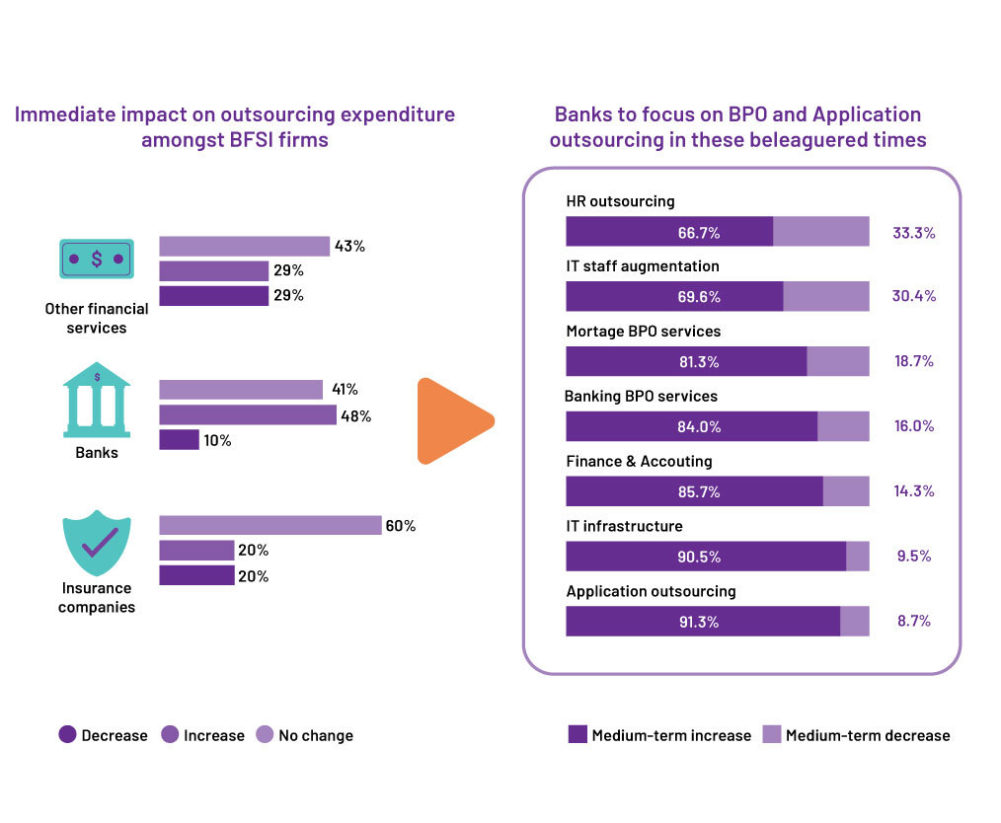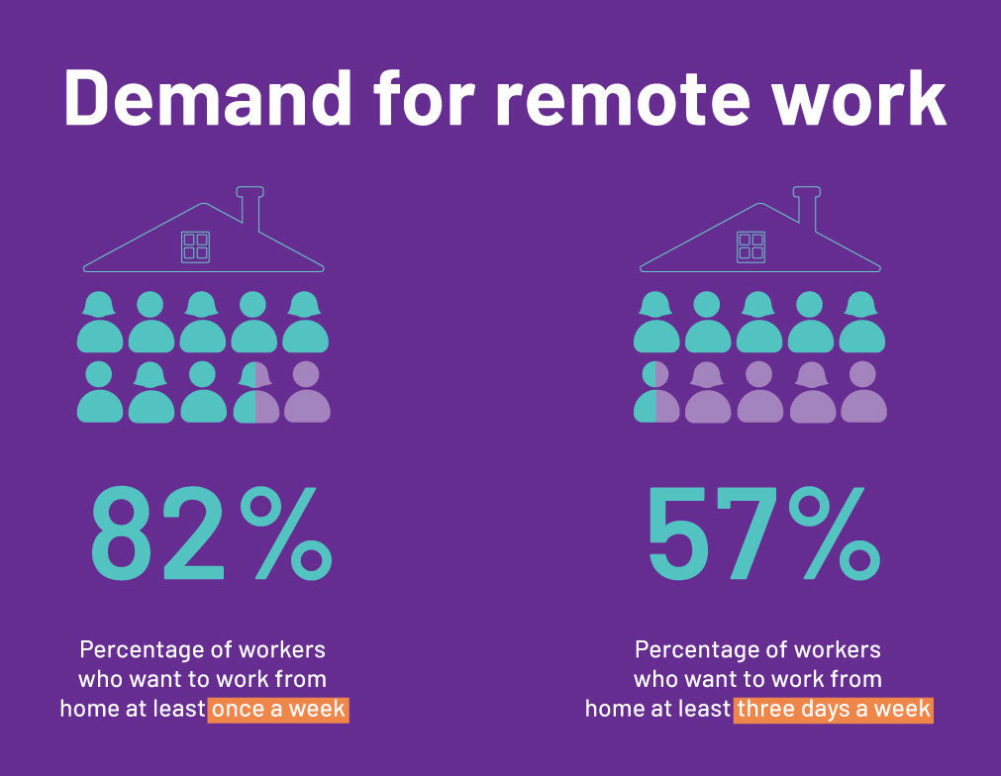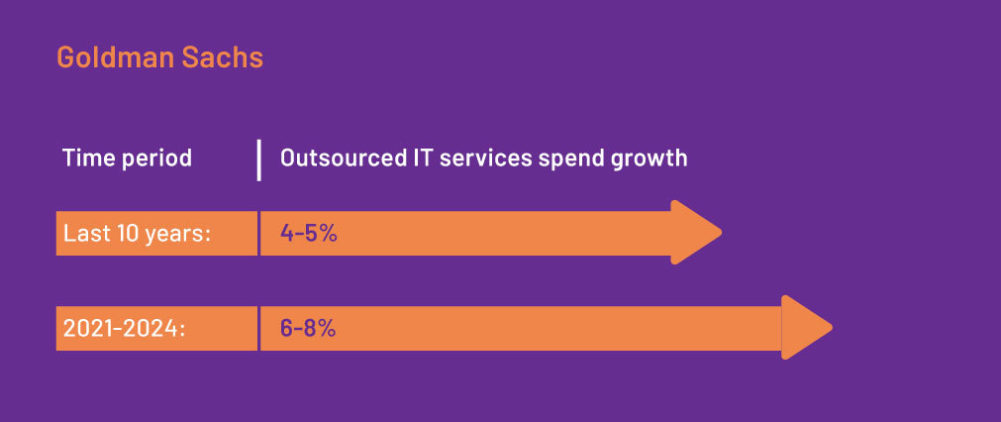All the successful technology companies in history have one thing in common: when they see a great opportunity ahead, they develop products and software to surf the wave at the right time. And the secret behind the speed of technology development at these companies is IT outsourcing. In addition to that, the best opportunities always arise from moments of crisis. The Y2K problem in 2000 and the financial crisis in 2008 were responsible for unleashing the first and second waves of mass outsourcing of technology services.
Now we are about to live through the third wave, caused by the coronavirus crisis.
According to Goldman Sachs, this wave has been boosted by the Covid-19 acceleration of ‘work from anywhere’ and is increasing technology demand globally, across industry verticals and geographies. Sachs estimates that IT service providers in India should reach a revenue growth of 13.1% in 2022 and 9.7% in 2023.
Because of it, companies are already looking for strategies of speeding up their product and software development entire model and also implementing actions to make their SDLC (Software Development Life Cycle) less costly and more scalable.
If you are one of them and need to find what are the outsourcing options and how to build a high-performance tech team and surf this third wave of IT demands post-covid-19, keep reading this article!
What is the third wave of IT outsourcing?
The third wave of IT sourcing is a new emerging trend of a sharp increase in outsourcing IT teams, particularly to India. This is an outgrowth resulted from the remote working model that is expected to last from now on.
Since the beginning of the pandemic, the home office has grown exponentially and pushed companies to adapt their business models from the planning and methodology to the code, deployment process, and software release. As time went by, many joined the home office permanently and announced that this would be their new normal.
Indeed, working from home is pushing the IT outsourcing third wave globally.
In a survey among British companies not currently using IT Outsourcing, 37% said they would consider outsourcing IT and development as a result of COVID-19.
Another survey showed that deep in the midst of the pandemic, over 60% of polled companies intend to speed up their digital transformation while 70% have plans to redo their products and services to drive greater customer value.
Tata Consultancy Services, a global leader in IT Services, for instance, is planning to have 75 percent of its employees working from home permanently by 2025 estimated and TechM is gearing for 25-30 percent of its employees working from home by 2021 estimated on a rotational basis, Goldman Sachs said.
This new scenario generated permanent cost advantages to the IT services such as IT infrastructure like desktops, wireless/broadband networks, and cyber-security tools. Also, companies need to prioritize the improvement of their software development process as soon as possible.
That’s why having distributed product and engineering teams has become an outsourcing solution to make the Software Development Life Cycle more flexible and scalable. Remote working is blurring the distinction between in-house, nearshore, and offshore teams. This creates opportunities for hiring high-level software developers from developing countries which is an alternative to save money without reducing software quality.
What are the differences between 2000 (first wave) and 2008 (second wave) and 2021 (third wave)?
The first wave of IT outsourcing happened in 2000 after the ‘Y2Y problem’ (abbreviation for the Year 2000 Software Problem), according to Wikipedia. It was also named the “Millennium Bug” because it was associated with the popular (rather than literal) roll-over of the millennium, even though most of the problems could have occurred at the end of any ordinary century.
The fear of the millennium bug prompted a massive renewal of IT resources (both software and hardware) and there was a mad rush to fix, update and test systems before the millennium shift took place.
Surprisingly few bugs have occurred, but the Y2Y fired up the rockets for Indian IT by introducing the opportunity of using cheap labor to architect applications and taking care of a company’s tech infrastructure remotely.
Goldman Sachs estimates that India’s IT industry was growing at more than 40 percent from a small base and very low global penetration, driven largely by labor cost arbitrage.
The second IT outsourcing wave started with the global financial crisis in 2008-2009. To reduce fixed costs, increase flexibility and increase profit margins, many companies invested in IT outsourcing.
Rapidly, this scenario has become positive to digital solutions development using the cloud, Artificial Intelligence, machine learning, and big data, while companies started looking at automation tools.
A survey conducted by an independent research firm AMR Research revealed that 48% of the banks surveyed were willing to increase their expenditure on outsourcing services. Though the Insurance sector was not too optimistic about outsourcing in the immediate term, firms were expected to adopt insurance-specific BPO services.
The 2008 financial crisis has also activated keen interest across stakeholders to understand adoption trends and opportunity areas in offshoring, among other cost-containment measures.

Impact on outsourcing expenditure. Source: The Global economic meltdown and its impact on Outsourcing
The third wave: what is coming
While COVID-19 vaccines are already out, global workers who were forced to work from home are not going to the workplace soon. Crucially, the logistics of producing vaccines enough for the global population is still a long way from optimum. Even with the global equitable access to COVID-19 initiated by the World Health Organization, the ACT Accelerator, the most optimistic global results would not be due until 2025.

82% of employees would like to WFH at least once a week. Source: Finances Online
Goldman Sachs expects that post Covid-19, opens the third wave of IT outsourcing, as a result of the home office adoption massive in full scale and the increasing number of technology roles globally.
Riding the third wave, Indian IT services behemoths are on the edge of doubling their market share, seeing double-digit revenue growth and wider margins. Goldman Sachs expects EBIT margins to improve in FY22E/23E led by operating leverage with double-digit USD revenue growth, a higher offshore mix, employee pyramid optimization, and an automation-first approach leading to non-linearity in revenues and lower sub-contracting costs.
According to Goldman Sachs, the cycle of this third wave should have three key stages:
- A large-scale shift to cloud: where IT companies, for example, in-house their intellectual property (IP), and where all the high-capital, intensive, non-core functions are outsourced to a secure hyperscale provider like Microsoft or Amazon. In this case, it will involve outsourcing to secure, professional and well-capitalized counterparties that are free from conflicts and can provide operational resilience.
- The building of applications in the cloud-native world: in this method, projects are made up of microservices housed in containers. Each microservice is designed to accomplish a single type of task and containers allow easy transfer of software between clouds. Also, the team uses continuous integration and continuous delivery to improve the application, which changes the approach to application production and maintenance drastically.
- The collaboration between IT service vendors and customers to build new technology solutions: Collaboration among IT service vendors and customers will help improve customer service across the board. Organizations with the best customer service have strong communication between all departments. For this to happen effectively, you need to have a strong structure based on people, process, and culture and also integrated systems.
What are the strategic reasons to use nearshore it outsourcing in the third wave?
An immediate action to scale a high-performance engineering team you should take to prepare your business after the crisis is the nearshore.
Outsourcing product and engineering teams, nearshore is a way to consolidate operations and reduce hiring costs without sacrificing high-level skills in your team or risk software quality. Nearshoring software development is a good option to consider because can access world-class software experts located in very similar time zones, making all the processes faster, less costly, and yield great results.
Working with nearshore teams you can hold similar time zones to avoid lack of visibility during the SDLC. Also, you let your company undertake larger and more strategic outsourcing in the long term, instead opting for more immediate cost savings through shorter outsourcing contracts with the ability to adjust volume and service level terms dynamically.
According to the Goldman Sachs report, the third IT outsourcing wave, a multi-year technology upgrade cycle is expected to have three key stages: a large-scale shift to the cloud, the building of applications in the cloud-native world, and collaboration between IT service providers and customers to build new technology solutions.

IT Services Outsourcing grows steadily. Source: Business Insider
That is why it is necessary to compose your team with key roles capable of meeting these new necessities and outsource closer to home. According to Avalon Global Research, Brazil, as a major nearshoring destination, maybe in a position to capitalize on some of the emerging changes and new opportunities within the outsourcing space.
Brazil is the leader in outsourcing in the Latin American region. Brazil enjoys numerous key benefits, from a sophisticated technological infrastructure, a strong and young employee base, proximity to the U.S., and a host of seasoned solutions providers skilled in the global sourcing market.
According to Brown and Wilson Group’s survey conducted in 2008, India remains the most preferred outsourcing location, based on current and past experience, for 73.5% of respondents. However, Brazil emerges as a strong potential alternative to India, with 87% saying they would consider outsourcing to Brazil for the right project.
But to succeed, it will need to align itself to the new dynamics in the market that are changing the way companies source, manage and benefit from outsourcing.
Why is working from home a trendy IT business?
In 2019, about 26.7 million US workers have started working remotely. That was about 23.7% of total workers in the United States. Because of the coronavirus outbreak that took the largest toll on the country, as much as 44% of them now work from home. This is especially true in the technology sector with popular companies, such as Airbnb, Twitter, Apple, and Google leading the charge.
Some benefits of working from home for both companies and employees include:
| Benefit | Stakeholder |
| Productivity increase: Studies show that telecommuting employees are 20% to 25% more productive than their office counterparts. Not only are there fewer social distractions, but there are also more opportunities to take necessary breaks when needed, which psychologists say helps with overall performance, motivation, and creativity— among other benefits. | Company and employee |
| Talent pools expand: Enterprise employers are no longer limited to hiring local talent, which means they have a far greater chance of finding someone with the exact skills, experience, and personality to fit best within their organization. Hire native speakers, bring in perspectives from other countries and cultures, and create a well-rounded group of professionals to innovate with. | Company |
| Have flexible hours: Working nine to five isn’t a realistic model for most employees because of differing energy levels, task durations, and personal schedule needs such as childcare dropoff or health and wellness days. Remote work allows employees to remain productive within the hours when they feel the most innovative, so they can plan for the right amount of task time, and accommodate basic needs. | Employee |
As a consequence of this massive home office model, the main challenge for IT Managers and leaders is to run the SDLC entire process remotely: plan, define, design, build, test, and finally develop.
To control each step of the Software Development Life Cycle, it must be mandatory to define a complete roadmap that allows managing different projects of different scales and complexity.
Process, goals, purpose, communication for your outsourced teams be fully integrated with your company and be prepared to invest time. The secret is to customize your recruitment process to hunt the best talents you can nearshore.
The third wave has already arrived. So to be successful in outsourcing high-performance IT teams and reduce operational risk to your business, it can be more efficient to find a partner to support you in hiring highly qualified people for your team.
By using a custom-curated methodology and the one-on-one approach to each candidate, Ubiminds establishes a solid Talent Sourcing Strategy to hunt and generate interest from these candidates. The higher the requirement level, the fewer candidates will be taken to the end of the process.
From the cultural characteristics to the tech skills and take-home tests, Ubiminds guarantees only the very best professionals, that’s why the process vets out 99.5% of candidates. If you are looking for time and costs saving for your Talent Sourcing process at the same time you need to increase the quality of profile candidates, talk to Ubiminds and find more.

International Marketing Leader, specialized in tech. Proud to have built marketing and business generation structures for some of the fastest-growing SaaS companies on both sides of the Atlantic (UK, DACH, Iberia, LatAm, and NorthAm). Big fan of motherhood, world music, marketing, and backpacking. A little bit nerdy too!









